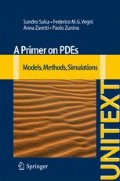Abstract
In this chapter we shall focus on models in which reaction and diffusion are in competition. Of particular interest is the study of the asymptotic behavior of the solutions as time goes on and to explore the existence and the stability properties of limiting steady states.
Access this chapter
Tax calculation will be finalised at checkout
Purchases are for personal use only
Notes
- 1.
Recall that, for Avogadro’s law, a mole of any substance contains the same number of molecules N = 6.022 × 1023 (Avogadro’s number).
- 2.
Appendix D.
- 3.
In fact, write Bessel’s equation (5.30) in the form
$$ \Big(r{u}^{\prime }{\Big)}^{\prime }-\mu ru=0. $$Multiplying by u and integrating over (0,R), we have
$$ {\displaystyle {\int}_0^R\Big(r{u}^{\prime }{\Big)}^{\prime } udr=\mu {\displaystyle {\int}_0^R{u}^2 dr.}} $$(5.32)Integrating by parts and using (5.31), we get
$$ {{\displaystyle {\int}_0^R\left(r{u}^{\prime}\right)}}^{\prime}\; udr={\left[\left(r{u}^{\prime}\right)u\right]}_0^R-{\displaystyle {\int}_0^R{\left({u}^{\prime}\right)}^2 dr=-{\displaystyle {\int}_0^R{\left({u}^{\prime}\right)}^2 dr<0}} $$and from (5.32) we get μ < 0.
- 4.
The zeros of the Bessel functions are known with a considerable degree of accuracy. The first five zeros of J 0 are: 2.4048 …, 5.5201…, 8.6537 …, 11.7915 …, 14.9309....
- 5.
Assuming that u t (x 0,t 0) and ∆u(x 0,t 0 ) exist. Otherwise we argue as in Theorem 3.2.
- 6.
Protter and Wienberger [10].
- 7.
The justification of this fact is not elementary and out of the scope of this introductory text. See for instance [15].
- 8.
See Salsa [15].
- 9.
See Murray [24].
- 10.
We have
$$ 3{m}^2-2{m}^3-3{\upsilon}^2+2{\upsilon}^3=\left(m-s\right)\left(3m+3\upsilon -2{m}^2-2 m\upsilon -2{\upsilon}^2\right). $$If υ → m
$$ 3{m}^2-2{m}^3-3{\upsilon}^2+2{\upsilon}^3\sim 6\left(m-\upsilon \right)\left(m-{m}^2\right) $$hence the integrand is of order (m – υ)-1/2 which is integrable near υ = m.
- 11.
The proof of this fact is not elementary and we refer to the original paper of Turing.
- 12.
See [43] for more details about these methods.
- 13.
Author information
Authors and Affiliations
Rights and permissions
Copyright information
© 2013 Springer-Verlag Italia
About this chapter
Cite this chapter
Salsa, S., Vegni, F.M.G., Zaretti, A., Zunino, P. (2013). Reaction-diffusion models. In: A Primer on PDEs. UNITEXT(). Springer, Milano. https://doi.org/10.1007/978-88-470-2862-3_5
Download citation
DOI: https://doi.org/10.1007/978-88-470-2862-3_5
Publisher Name: Springer, Milano
Print ISBN: 978-88-470-2861-6
Online ISBN: 978-88-470-2862-3
eBook Packages: Mathematics and StatisticsMathematics and Statistics (R0)

